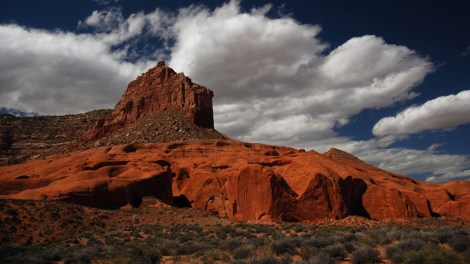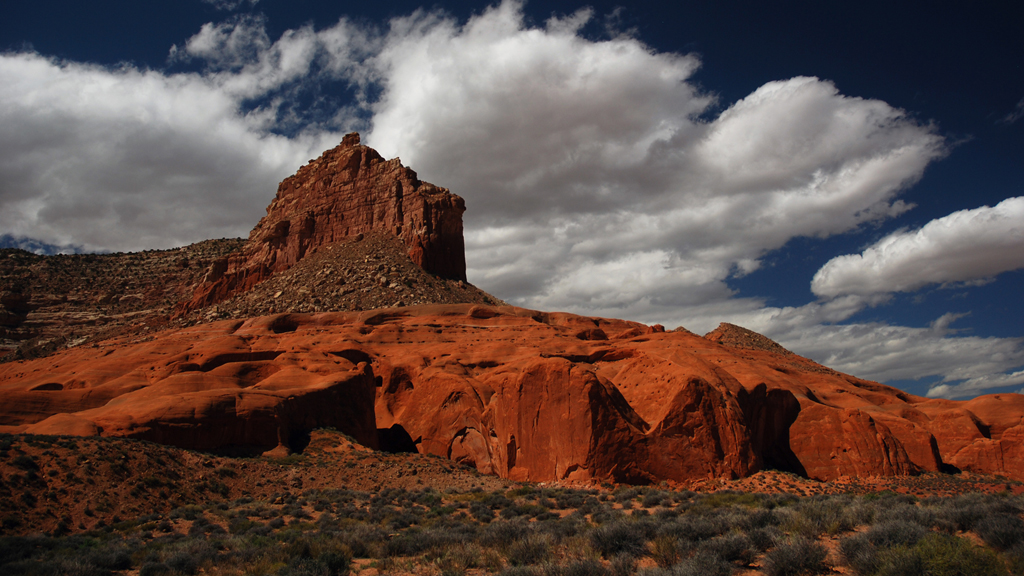
Penny MeyerSort of like this, but covered in oil.
When oil spills across a national monument, and no one is there to see it, does it still leave a mark?
Apparently a really big one, but one that still takes a while to find. According to the Salt Lake Tribune, Utah’s Bureau of Land Management (BLM) just discovered four miles of oil damage in the Grand Staircase Escalante National Monument — thanks to some thoughtful hikers who stumbled onto the scene and photographed the evidence.
Normally, the monument looks like the backdrop of a motivational calendar, but the area the hikers found was black and streaky. There were black bathtub rings around trees and rocks at the level of the spill’s highest reach. The overall effect was like that of a really poorly executed Andy Goldsworthy installation, or the mess left in the wake of the Cat in the Hat, if the Cat in the Hat were a wildcatter.
The issue of a four-mile oil spill in a scenic part of the country that people actually go to great efforts to walk through raises some interesting questions about the possible existence of unreported spills in less attractive parts of America. Pipelines, which are often buried underground, in out-of-the-way places, aren’t easy to monitor. According to data from the Pipeline and Hazardous Materials Safety Administration (PHMSA), remote sensors detected only 5 percent of the nation’s pipeline spills between 2002 and 2012. Pipeline company employees reported 62 percent, and the rest — nearly a quarter — were reported by regular citizens.
Some people whose property is close to pipelines they don’t trust have taken it upon themselves to set up a sort of neighborhood pipe watch, so that they have better odds of catching a spill when it happens. According to a BLM spokesperson, the field team dispatched to the site of the Utah spill reported that the flooding that carried oil through the monument happened last fall, but that the original leak that first released the oil could have happened years ago.
Where did the oil come from? According to the BLM, there’s only one possible culprit: an oil field 10 miles away in the Upper Valley. That oil field was set up back in the 1960s, when the land was public land, but not super fancy national monument-type public land. That means it is allowed to keep on producing oil — as a “pre-existing use.”
The field is operated by Citation Oil and Gas Corp, which hasn’t been returning the BLM’s phone calls, but which did get busted by the state Division of Oil, Gas and Mining (DOGM) for a leak from the same field two years ago. By law, any oil spill into a park or waterway is considered major, and requires notifying authorities within 24 hours, but Citation didn’t report that leak, either.
Which raises the question: If you’ve got a leaky oil field with aging infrastructure that just happens to be inside a national monument, how do you go about bringing it into regulatory compliance, or, failing that, shut it down? Both the Utah Department of Commerce and the PHMSA say, basically, “Don’t look at us” — pipelines like the ones in the Upper Valley field aren’t in their jurisdiction. The DOGM, which intervened the last time, says that it’s not responsible for oil once it leaves the oil well. It suggested getting in touch with the Forest Service.
All of which means that, even as we’re surrounded by tales of dramatic oil spills in places like Galveston and Michigan, there’s reason to get paranoid. If this administration is serious about pipeline safety, it should be thinking about the oil spills that we might not be seeing, as well as those that we are.



